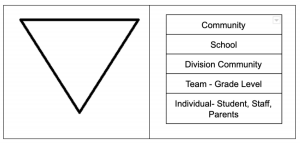
I continue to very much enjoy my class on wellness through George Mason University. My professor, Dr. Thurston, recently gave us the following task, which falls very much within my wheelhouse. Hopefully, my next school will already have a wellness program in place. If not, my write-up can be a starting point for me to put forth a proposal not constrained by the word count for this assignment. I also would, in PosPsych fashion, not focus on the negatives but rather look at how to help all community members flourish.
Assignment: Imagine you are the director of professional development for a large, K-6 public school. Burnout has become a significant issue for your school. The principal has asked YOU to develop a program 1) to help prevent burnout for teachers and 2) to help those teachers who are already experiencing burnout to find resilience and bounce back from it. The principal wants your support and training program to especially 1) promote mind-body wellness and 2) cultivate a renewed sense of meaning in being a teacher.
A Professional Development Plan to Prevent Burnout
As the director of professional development here at our school, I am writing to you as our principal, requesting your feedback and ultimate approval of a personal and professional learning program for our teachers designed to support and enhance their mind-body wellness while also focusing on our teachers who are currently experiencing burnout. I will offer some background information about negative factors affecting the nature of being in a helping profession. But the main thrust of this proposal is to provide learning opportunities to enhance physical health and mind-body wellness using the tenets of Positive Psychology which we introduced to the staff at the end of last year. With your insights and guidance, we can review some programmatic offerings for a sustained year-long effort to further support the wellness of our professional learning community.
Background:
Let me start with some research by Dr. Cary Cherniss and Dr. Thomas Skovholt that deals with helping professions and the factors affecting burnout. Both authors highlight the importance of caregivers knowing about factors affecting potential burnout and how to prevent it.
Dr. Cherniss shares several conclusions regarding reasons for burnout with stress, institutional struggles around workplace bureaucracy, societal expectations, and not feeling supported as being a few primary drivers. The research shows that these factors lower caregiving professionals’ initial idealism and belief in the meaning of their work, possibly then leading to more self-protection, lowering expectations for clients, and having less energy devoted to work.
Dr. Skovholt’s work centers on the importance of meaning, building resilience, and the factors that do and don’t sustain the professional self. His research shows that experiencing a sense of meaning and purpose ebbs with giving professionals when they don’t feel they are making a difference in their work. He points out that helping professionals can control the advancement of their expertise and the quality of their relationship with their clients. However, they don’t have control over their clients taking steps to make needed changes in their lives. Dr. Skovholt stresses the importance of balance in work/personal life and the unhealthy nature of overly attaching to one’s clients.
Program Development:
Step 1: I propose that we start our wellness program with a full-day whole-staff kickoff introduction to our PD plans for the year. A primary focus of the first PD session will be to share information about what it means to be in a helping and meaningful profession that comes with challenges to the point of possible burnout. I can see us doing a thinking routine like Compass Points to have table groups respond to the italicized statement I just listed.
After plenty of discussion and sharing table responses to the thinking routine, we provide information from the research by Dr. Cherniss and Dr. Skovholt. We would move from the negative factors affecting teachers into a problem-solving mode to understand what makes teaching meaningful. We would also look to decrease stress and stop potential burnout by offering several of Dr. Skovholt’s support strategies (see below for examples listed under PERMA(H) – Meaning).
Everyone’s homework will be to take the VIA Character Strengths survey. We will give a due date for everyone to complete the survey and notice that we will have a mini-workshop prepared for teams to discuss and build an understanding of the strengths. We then finish the day by reintroducing Positive Psychology to the staff, emphasizing how we will use the PERMA(H) construct and the Character Strengths as our vehicle for learning about and applying wellness principles to our lives.
Step 2: A natural tendency is to emphasize the needs of those who are struggling, as in our teachers who are already experiencing high levels of stress, anxiety, and in some cases, burnout. Going forward, I propose we take a constructive and empowering Positive Psychology approach that offers wellness information and support strategies to all of our teachers, moving everyone to a more mind-body solid sense of well-being with the knowledge that some will start their learning in more challenging situations.
Thus, we build on our introduction efforts from last year around well-being based upon the Positive Psychology “exercising” of the Character Strengths, the PERMA(H) pillars stressing the importance of the meaning and positive emotions in the lives of caregivers, and the value of life satisfaction with a focus on mindfulness as a tool among to help our staff flourish.
Just as we differentiate for our students, I propose that we offer added support for those with more needs while giving everyone a menu of strategies to individualize their wellness planning and implementation efforts while also working with their grade level and specialist (i.e., art, PE, library, student support) teams. Teachers can work independently and with their teams with the option of having a “wellness buddy” for reflection and motivational purposes. It will be up to you to decide how much attention and which teams might need to work on their wellness, especially regarding relationships and functionality.
This hybrid approach would include the development of a “Wellness Learning Portal” to provide background information on Positive Psychology and other aspects of mind-body well-being. The site would be organized at the top level around the PERMA(H) pillars, including strategies on how to engage the Character Strengths within each PERMA(H) pillar offering staff members a construct to organize their thinking and actions towards enhancing their well-being.
We would offer designated individual and team-protected time to work on activities listed within the portal. We would gather feedback as we proceed to design whole staff reflection and sharing times as we progress through the year. The emphasis, though, would not be on all staff PD sessions.
I propose starting with a life satisfaction survey and a resilience inventory to get a baseline of where everyone stands now. We can then give each instrument at the end of the year to measure the effectiveness of our efforts. The results can help our counselor/wellness coach quickly move to work with individuals dealing with burnout to help them create wellness plans and to receive ongoing life coaching.
We can offer a few specifics within each PERMA(H) pillar through our portal. A theme for each pillar is to ask our teachers which character strengths they can dial up within each pillar to further enhance their wellness.
Positive Emotions – Offer a list of activities and character strength engagements that lead to positive or those that can lead to uncomfortable emotions. Provide guidance in choosing positive experiences that lead to positive emotions by offering the Positivity Self Test. Provide research on the power of positive thinking and learned optimism. Journaling is a helpful tool for this pillar.
Engagement – Offer an inventory that helps teachers reflect on which activities under which circumstances deepen their engagement in their activities. Include background information on experiencing a state of flow. We can offer an array of mindfulness techniques, including meditation. I could see setting aside a portion of one of our staff PD sessions to share the science-supported benefits of mindfulness and misconceptions while also taking a deep dive into the core elements of intention, attention, and attitude.
Relationships – Offer articles on the importance of relationships for well-being, including the research on inhabitants of blue zones worldwide. List strategies to help build active listening and Active Constructive Responding (ACR) communication skills. We can offer a full menu of team-building and wellness activities.
Meaning – Take a deep dive into articles on helping professionals and the importance of self-care while finding meaning in one’s work. Design an activity to engage staff with the four needs for meaning by Baumeister and Wilson (i.e., purpose, value and justification, efficacy and autonomy, and control).
We would then offer strategies to sustain one’s professional self. Here are a few strategies offered by Dr. Skovholt.
- Distinguish between idealism and realism
- Take care of yourself first – As told on airplanes, first put on your oxygen mask and then that of your child.
- Seek balance while at times dealing with negative self-talk around feeling selfish for taking care of your needs
- Setting healthy boundaries for yourself.
- Build a support network and look for opportunities to mentor others which gets at the R in PERMA(H)
- Maximize successes
- Find ways to bring play into our lives
Accomplishment – Providing ways to set goals and engage a Growth Mindset comes into play along with the strengths of resilience and perseverance.
Health – We can offer physical and mental support strategies in our wellness portal, including diet, fitness, sleep, and a further focus on whole-body wellness.
Step 3: Another delivery instrument for our wellness program is creating and implementing a wellness plan by individuals and possibly by teams. The wellness plan would include setting personal wellness goals. Here is a family wellness template that can be adapted for our purposes.
Step 4: Connecting to our other initiative to integrate wellness principles into our classroom curriculum, I propose that all staff members make one of their professional goals to increase their knowledge of Positive Psychology to be ready for our student wellness program implementation.
Final Thoughts:
This staff member wellness program outline is a starting point for us to build from. I would like to form a wellness team of interested staff to fully design and implement the program.
Image Source

 Student journaling to reflect on school subjects and/or unique ideas is a powerful and proven tool. Several of my posts cover this topic of student
Student journaling to reflect on school subjects and/or unique ideas is a powerful and proven tool. Several of my posts cover this topic of student 

 This is another post that has been sitting in my draft folder for a long time. I originally planned it for my “what if we…” series. My title was “What If We…Really Built and Sustained a Community Wellness Program”. We have scientifically proven tools through Positive Psychology to help individuals, teaching teams, and the greater community improve their well-being. This is a big honker of a wish, but I think it is doable, especially in a world with many stressors, including the need for digital wellness and individuals struggling with physical and mental health.
This is another post that has been sitting in my draft folder for a long time. I originally planned it for my “what if we…” series. My title was “What If We…Really Built and Sustained a Community Wellness Program”. We have scientifically proven tools through Positive Psychology to help individuals, teaching teams, and the greater community improve their well-being. This is a big honker of a wish, but I think it is doable, especially in a world with many stressors, including the need for digital wellness and individuals struggling with physical and mental health.

 How mindful is your team? The Harvard Business Review articles “
How mindful is your team? The Harvard Business Review articles “



